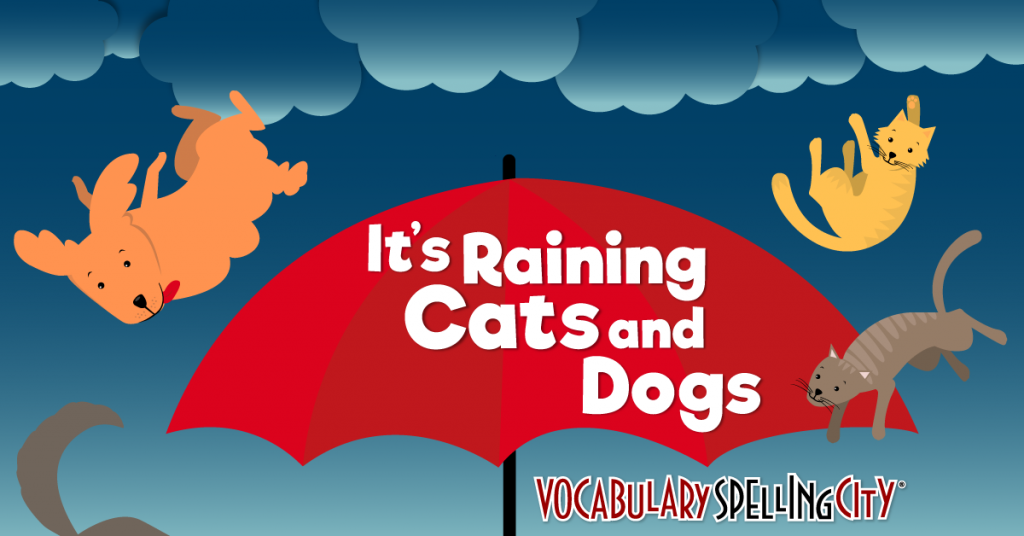Tim Rasinski is a renowned professor of literacy education whose research on reading fluency and word study has made him a literacy hero to many. Below, he shares his thoughts on teaching idioms.

Some of the most challenging words (and phrases) for students to learn are those that are metaphorical in nature – words not meant to be taken literally. Idiomatic expressions, a type of figurative language, are among the most challenging words for students to learn. Expressions like going bananas, it’s raining cats and dogs, a chip on your shoulder, and it’s all Greek to me, are not to be taken literally. The meaning of these expressions is hidden. It is up to the listener or reader to understand the underlying meaning of such expressions. Whether written or spoken, idiomatic expressions are common. Authors use idioms to make their writing more interesting and authentic.
Yet, unless the reader understands the hidden meaning of the idiom, s/he will have difficulty understanding the text in which the idiom is situated. Given the importance in understanding idioms, it seems reasonable to expect that figurative language, and idiomatic expressions in particular, be an integral part of a reading/language arts curriculum. However, if you take a look at reading and language arts instructional programs, you will find, at best, only a limited amount of coverage in any such topics. So what to do?
There are literally hundreds of idioms that are worth teaching. One approach that I might suggest is to teach idioms by themes or topics. At the beginning of the week, identify a theme that contains a number of idiomatic expressions. The website The Idiom Connection has organized expressions by theme. There you will find themes such as clothes idioms, animal idioms, number idioms, sports idioms, and more. Select (or ask your students to select) 8-10 idioms that belong to the chosen theme. Display these idioms on a chart along with their underlying or hidden meaning. Below is a chart for dog idioms.
Keep the display up throughout the week and encourage students to use the displayed expressions in their own oral and written language. For example, you might ask students to use at least one idiom in their personal journal at the end of each day. Of course, if you want students to use the expressions, you’ll need to find ways to use them yourself. For example, if a student provides an incorrect response to a question, you might say that he’s “barking up the wrong tree,” or if you don’t think the school principal will like an idea you might say, “well you just can’t teach an old dog new tricks,” or if you have a group of students who are “hounding” you with a request, you might tell them to “call off the dogs.” As you can probably see, finding ways to use these expressions is a fun challenge for both you and your students.
After having playfully used the idioms throughout the week students will probably have a good understanding of them. But if you want to take it one step further, at the end of the week ask students to work by themselves or with a partner to write a paragraph or two that summarizes the work done over the week or the plans students might have for the weekend and embed as many of the week’s expressions as possible. Here’s an example of what one student wrote recently:
“My sister and I have been hounding our parents to take us to the high school football game this weekend. Since he didn’t want to be in the doghouse, Dad finally told us to call off the dogs – he agreed that he would finally take us. However, since it is supposed to rain cats and dogs this weekend, we think we might ask Dad to let sleeping dogs lie and wait for another day to take us to a game.”
Can you imagine the fun of having students read and discuss their short compositions with their classmates on a Friday afternoon? Moreover, you can save the very best essays to share with students in the following school years. Learning to read and learning words should be fun. Bringing idioms into your classroom is sure to add joy and authentic learning to your classroom experience.
Other Idiom Resources:
- VocabularySpellingCity – A great resource for finding and using idiomatic expressions with students.
- Go Figure! Exploring Figurative Language -Instructional activities for teaching idioms and other forms of figurative language. Features texts containing targeted words and expressions.
- Idioms And Other English Expressions – Strategies and suggestions about how to introduce idioms and incorporate them into your language and writing instruction.
- Tim Rasinski’s website – Find blog posts and resources that feature idioms.
_________________________________________
Tim Rasinski is a professor of literacy education at Kent State University. His research on reading has been cited by the National Reading Panel and has been published in journals such as Reading Research Quarterly, The Reading Teacher, Reading Psychology, and the Journal of Educational Research. Read more about Rasinski here, or connect with him on Twitter @timrasinski1.
For more from Tim Rasinski, continue to follow us for his exclusive VocabularySpellingCity blog series and be sure to watch a video recording of his webinar “Automaticity (Fluency) in Word Learning Improves Comprehension”
Rasinski’s research on word fluency is cited in the report, “Applying Best Practices For Effective Vocabulary Instruction,” written by VocabularySpellingCity in partnership with McREL International.
No comments:
Post a Comment